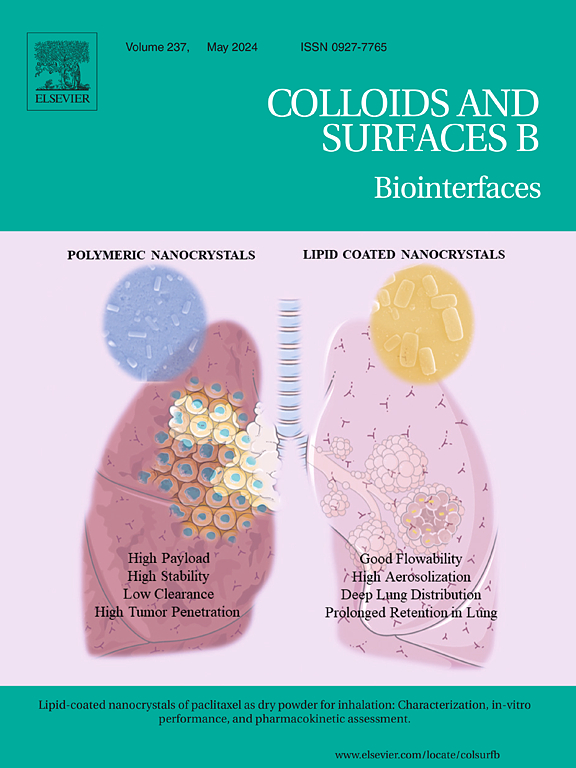Sprayable ciprofloxacin loaded chitosan nanospheres-based topical formulation for eliminating multidrug-resistant bacteria and accelerating infected wound healing
IF 5.4
2区 医学
Q1 BIOPHYSICS
引用次数: 0
Abstract
Multidrug-resistant (MDR) bacteria represent a formidable global health crisis with a substantial risk of prolonged infections due to the diminishing efficacy of traditional antibiotic therapies against these resilient pathogens. A dual strategy offering rapid inactivation of MDR bacteria and reduction in wound area could effectively promote wound healing. In this work, we developed a sprayable topical formulation by integrating a biocompatible biopolymer chitosan with a chemotherapeutic drug ciprofloxacin. The as-developed ciprofloxacin-loaded chitosan nanospheres (CIP-CNSs) exhibited a high encapsulation efficiency (70 %) and robust in vitro antibacterial activity against different MDR strains such as E. coli, S. aureus, and P. aeruginosa. However, CIP-CNSs did not induce any adverse side effects either in vitro or topically on the skin as confirmed by cytotoxicity assay and acute dermal irritation test. Moreover, in albino rabbits wound model, CIP-CNSs significantly accelerated wound healing with a wound closure rates of 75–85 %, within the first-week of post-incision, as compared to a commercial ointment. Furthermore, histopathological staining confirmed faster re-epithelialization and collagen deposition in wounded regions, without any hemorrhage or tissue infection. This study underscores the potential of CIP-CNSs topical formulation as a viable therapeutic strategy against the burgeoning threat of MDR-associated wound infections.
负载环丙沙星的壳聚糖纳米球外用喷雾剂用于消除多重耐药细菌和加速感染伤口愈合
耐多药(MDR)细菌是一种可怕的全球健康危机,由于传统抗生素治疗对这些具有弹性的病原体的疗效逐渐减弱,具有长期感染的重大风险。快速灭活耐多药细菌和减少创面面积的双重策略可有效促进创面愈合。在这项工作中,我们通过将生物相容性生物聚合物壳聚糖与化疗药物环丙沙星结合,开发了一种可喷雾的局部配方。制备的环丙沙星壳聚糖纳米微球对大肠杆菌、金黄色葡萄球菌和铜绿假单胞菌等多种耐多药菌株具有较高的包封率(70%)和较强的体外抗菌活性。然而,细胞毒性试验和急性皮肤刺激试验证实,CIP-CNSs在体外和局部皮肤上均未引起任何不良反应。此外,在白化兔伤口模型中,与商业软膏相比,CIP-CNSs在切口后第一周内显著加速伤口愈合,伤口愈合率为75 - 85%。此外,组织病理学染色证实损伤区域的再上皮化和胶原沉积更快,未见出血或组织感染。这项研究强调了CIP-CNSs外用制剂作为对抗耐多药相关伤口感染威胁的可行治疗策略的潜力。
本文章由计算机程序翻译,如有差异,请以英文原文为准。
求助全文
约1分钟内获得全文
求助全文
来源期刊

Colloids and Surfaces B: Biointerfaces
生物-材料科学:生物材料
CiteScore
11.10
自引率
3.40%
发文量
730
审稿时长
42 days
期刊介绍:
Colloids and Surfaces B: Biointerfaces is an international journal devoted to fundamental and applied research on colloid and interfacial phenomena in relation to systems of biological origin, having particular relevance to the medical, pharmaceutical, biotechnological, food and cosmetic fields.
Submissions that: (1) deal solely with biological phenomena and do not describe the physico-chemical or colloid-chemical background and/or mechanism of the phenomena, and (2) deal solely with colloid/interfacial phenomena and do not have appropriate biological content or relevance, are outside the scope of the journal and will not be considered for publication.
The journal publishes regular research papers, reviews, short communications and invited perspective articles, called BioInterface Perspectives. The BioInterface Perspective provide researchers the opportunity to review their own work, as well as provide insight into the work of others that inspired and influenced the author. Regular articles should have a maximum total length of 6,000 words. In addition, a (combined) maximum of 8 normal-sized figures and/or tables is allowed (so for instance 3 tables and 5 figures). For multiple-panel figures each set of two panels equates to one figure. Short communications should not exceed half of the above. It is required to give on the article cover page a short statistical summary of the article listing the total number of words and tables/figures.
 求助内容:
求助内容: 应助结果提醒方式:
应助结果提醒方式:


